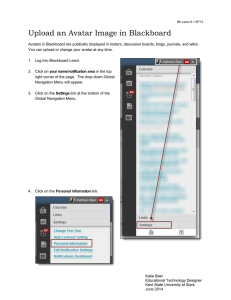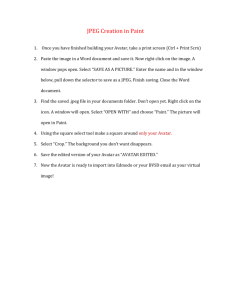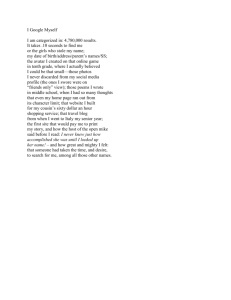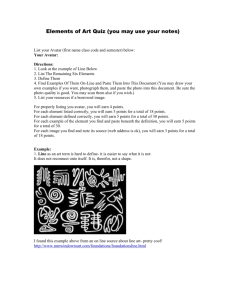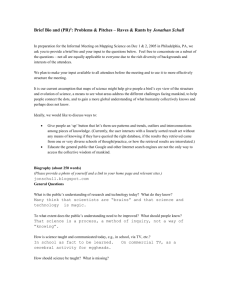Information Spaces — Building Meeting Rooms in Virtual Environments Abstract
advertisement
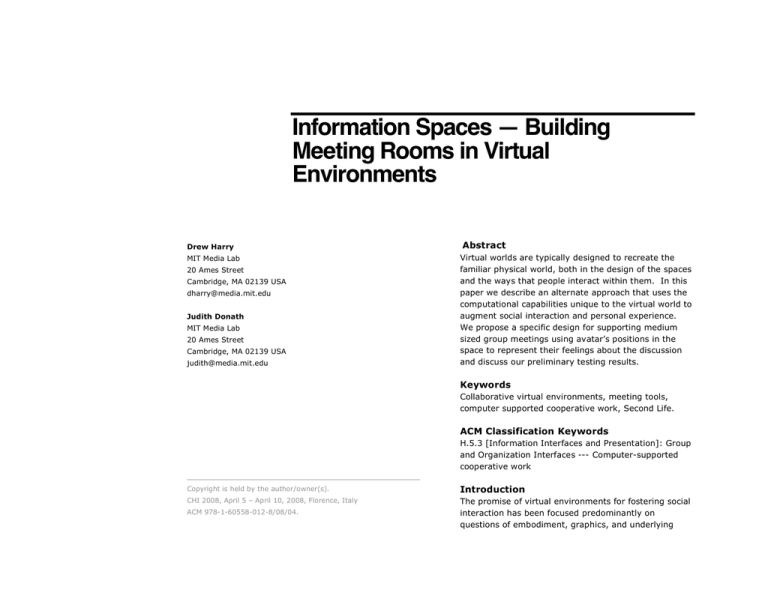
Information Spaces — Building Meeting Rooms in Virtual Environments Drew Harry MIT Media Lab 20 Ames Street Cambridge, MA 02139 USA dharry@media.mit.edu Judith Donath MIT Media Lab 20 Ames Street Cambridge, MA 02139 USA judith@media.mit.edu Abstract Virtual worlds are typically designed to recreate the familiar physical world, both in the design of the spaces and the ways that people interact within them. In this paper we describe an alternate approach that uses the computational capabilities unique to the virtual world to augment social interaction and personal experience. We propose a specific design for supporting medium sized group meetings using avatar’s positions in the space to represent their feelings about the discussion and discuss our preliminary testing results. Keywords Collaborative virtual environments, meeting tools, computer supported cooperative work, Second Life. ACM Classification Keywords H.5.3 [Information Interfaces and Presentation]: Group and Organization Interfaces --- Computer-supported cooperative work Copyright is held by the author/owner(s). Introduction CHI 2008, April 5 – April 10, 2008, Florence, Italy The promise of virtual environments for fostering social interaction has been focused predominantly on questions of embodiment, graphics, and underlying ACM 978-1-60558-012-8/08/04. 2 technology. In this paper, we shift our attention to the kinds of spaces we're building in virtual environments. By focusing specifically how virtual spaces can be much more than renderings of physical architecture, we can create spaces with a new sort of information architecture. By working with these native properties of virtual space, we can create interactive social experiences that go well beyond being there.[1] Our approach focuses on using the programmatic flexibility of virtual space to create environments unlike those seen in existing virtual world platforms. Much of the art in designing a space is in understanding how the characteristics of the space influence the inhabitants’ attention, mood and sense of intimacy. In the physical world, this is done by changing features such as lighting or the number and arrangement of seats in a room. The virtual world potentially offers a vast range of such socially significant functions. We can, for example, embed functionality in the space itself that provides a sense of history through visualization, controls how people's avatars are rendered, changes how far away chat messages can be heard, modifies how avatars move through the space, or makes avatars anonymous. By combining these different techniques, we can craft virtual environments that afford social interactions quite different than those that we're used to in face to face situations. This approach is in stark contrast to most modern commercial virtual environments such as Second Life, Habbo Hotel, World of Warcraft, or Club Penguin. In these worlds, all spaces are functionally equivalent. Although spaces are rendered differently (often explicitly referencing familiar physical metaphors), they behave in the same ways. Basic movement, chat, and other social functions operate in the same way anywhere in the world.[2, 3] In this paper, we focus specifically on the design of information based spaces that support meetings among groups of 10-20 people. We describe the details of one specific meeting space that uses avatars’ positions in the space to represent their feelings about the discussion. We have implemented these designs using Second Life. Second Life provides most of the features we need to build effective experiments in this design space. Perhaps most importantly, the Second Life client runs on all major operating systems with no special hardware requirements. This has helped create a large existing user base that makes broad testing and deployment very accessible relative to other platforms.. Related Work Although we are not building our own virtual world platform in this work, the tools we use owe a clear debt to the early screen-based environments like MASSIVE[4] and DIVE[5]. In particular, the work by MASSIVE’s authors on spatial models is particularly relevant to our work.[6] Much of the inspiration for our design approach came from the Chat Circles series of pieces[7]. These simple virtual environment designs suggested ways to use space and history aggregation to support socialization in a variety of different ways.[8] Our augmentation of a meeting space with visualizations of the meeting’s conversational content is inspired by the Visiphone[9], Conversation Clock[10], 3 and Second Messenger[11] projects. While those projects focused primarily on the audio content of the meeting, we have developed a variety of techniques based more on the spatial aspects of meeting in a virtual environment. Design group’s attempt to reach consensus. Of course, not everyone always wants to reveal their opinion about the issue at hand. Surrounding the main agree/disagree field is an area for people to stand who want to participate in the discussion without putting their avatar on the continuum. Still further from the field is an observation area for people who want to be present, but not participating. Finally, there is a platform for the moderator with controls to manage properties about the space itself. This layout is shown in Figure 1. Although the examples in this paper are all based around the Agree/Disagree continuum, our design supports other options as well including a more process oriented Keep Talking/Move On field. This spatial approach is a powerful organizational metaphor because it both relies on our knowledge of the meanings of position relative to other people in physical spaces[16] and the metaphors inherent to interactions in a spatial environment.[17] In meetings with more than a few people, it can be challenging to understand other people’s feelings about an issue, reach concensus, and influence others. Even logistical tasks like staying on an agenda and distributing tasks appropriately can be difficult. Our design addresses these collaboration challenges by creating a meeting space focused on non-verbal signalling using avatar positions. The virtual-ness of the space allows us also to include a set of social utilities to support the continuous presentation of the contributions and shifting viewpoints of each participant. For this application, the core functional elements of the space are visualizations that portray the history of movements and conversation in the space. Our space is divided into four major zones. The main area is like a traditional sports field with end zones labeled “agree” and “disagree”. It provides a space for people to position their avatars on a continuum to show their attitudes about the issue under discussion. The fluid self-arrangement of people within this space based on their opinions provides a literal basis for seeing where someone is coming from and the status of the Position History When an avatar pauses for a while, a transparent column slowly rises out of the ground. When the avatar moves, the column slowly shrinks and eventually disappears. In this way, an avatar’s presence leaves a temporary mark on the space , providing a more nuanced view of the meaning of their location. Someone who has been standing on the agree side of There has also been a variety of relevant work exploring the role of space in games. Although massively multiplayer games have simple spatial models, many smaller sized games have a very rich approach to space which have been discussed about in a number of venues.[12, 13] Figure 1 - A top down view of the meeting space layout. Figure 2 - A dwell indicator, growing slowly beneath a stationary avatar. There are also a number of fascinating projects going on in Second Life exploring these issues. In particular, the Studio Wikitecture[14] and Responsive Architecture[15] projects relevant to this work. 4 the field for the entire discussion is quite different from someone who just arrived there; this approach distinguishes those meanings visually. When an avatar moves around in this space, a trail is drawn behind them. This contextualizes current positions much like the dwell indicators do. Someone with a short dwell indicator and a trail shows both that they have moved recently and indicates where they moved from. Figure 3 - A movement trail, created behind an avatar that just stopped moving. Older segments are fading away. Chat History The space also records typed contributions in text boxes that appear above the speaker’s head and then rise slowly. This creates a visualization of chat over the course of the meeting, displaying what was said, when it was said, and where in the room the avatar was when they said it.[9, 11] In aggregate, it also shows that patterns of conversation of the course of the meeting. Average Finally, the floor of the agree/disagree field displays the current average vote, as well as its deviation. Like chat messages, a representation of the group’s collective view also floats up into the sky, providing more context about the overall feeling of the avatars in the space over time. Figure 4 - Archival chat boxes rising above the head of an avatar. The wide vertical bars show the average vote when each message was typed. Other Social Utilities The social utilities described above create a space in which people’s interactions with the space represent a new kind of social vocabulary based on position. This is just one way in which one can combine social utilities with the design of the space to create a specific kind of social space. Much like we use lighting in physical spaces to change the mood of the space, we can imagine turning on and off a variety aspects of the space to change its social affordances. We could control the level of archiving, whether avatars are anonymous or not, and how far chat travels. Various data about participation can also be visualized in the space or on the avatars to encourage different participation patterns. This design space is rich with opportunities for adjusting the social functionality of the environment to afford different kinds of social spaces. To-dos and Voting The Todo application creates small pyramids, which can store a bit of text — nominally a task for someone to do. Avatars can click on an extant task to claim it. The pyramid then hovers over the avatar's head and follows them around. This serves as a visual reminder to everyone in the meeting who has volunteered to complete specific tasks. The Voting application makes it easy to hold quick adhoc approval votes. Moderators can give the voting application a notecard with topics to be voted on, and it makes objects that represent each choice. Participants can then vote (anonymously) for their preferred choices. This application also doubles as an Agenda system, where each item represents a discussion topic, and votes can be about which topics to discuss. Evaluation We have conducted some preliminary evaluations of this approach. We worked with two existing discussion groups in Second Life to arrange meetings inside an early prototype design. The first group had 7 participants and the second group had 12 participants. Each group was given a list of controversial topics and 5 Figure 5 - A combination of movement history (at ground level) and average vote history (rising above the meeting space) asked to vote on which one they were most interested in discussing. After choosing a specific topic, they were given an editorial on that topic and then asked to move their avatar to represent whether they agreed or disagreed with the author's argument and to hold a discussion about their opinions on the topic. After the discussion, feedback about the meeting space was collected informally through both individual conversations with participants and group comments. Future evaluations will focus on using the meeting spaces with formal work teams inside companies. The people involved in the study will be familiar with Second Life's interface, so we will be able to get beyond some of the basic usability problems and explore the important design questions around building social spaces in virtual environments. We will use voice chat for the primary communication channel, which should help relieve the interface modality issues we faced. Participants were, on the whole, very excited about the potential of the design space. Many of them focused on the social implications of this arrangement, thinking out loud about how they would respond to, e.g., their boss moving to “agree”. They also appreciated the way the space aggregates history, because they were often pulled away from Second Life briefly and lost track of what was going on otherwise. Conclusions and Future Work In these tests, though, participants rarely moved their avatars around the space to take advantage of the many visualization features. This was due to the modality of the Second Life interface. When we were ran these studies, Second Life did not support voice chat (it has since been added), and avatar movement is controlled by the keyboard. This makes it hard for avatars to both move and talk at the same time. The other major theme from these experiences was that even relatively sophisticated Second Life users make infrequent use of the elaborate camera controls. As designers, we assumed that all users would be comfortable detaching the camera from their own avatar and inspecting objects in the environment—the conversation archive, in particular. This was not the case with our test groups. Although we are in the early stages of building designs using this approach, we believe there is great promise in this largely overlooked design space of functional virtual space. By building virtual spaces to foster particular kinds of social spaces, we believe we can use virtual environments to take us beyond being there, tailored for different kinds of activities. Ultimately, we see desktop computer based virtual environments being another useful tool for synchronous distance collaboration that coexists with video conferencing, audio conferencing, and screensharing. There are a number of ongoing challenges in this space that our future work will address. We are in the process of developing new designs for other social experiences other than meetings. These future designs will help flesh out the design space further. These subsequent designs will probably be built in a custom virtual environment platform that supports a more flexible model of space, avatar and identity representation, and movement. More generally, developing experiences in virtual environments suffers from a lack of good user interface metaphors. While desktop interface widgets have 6 become relatively standardized and users have a general understanding of many interface elements, users in virtual environments suffer from both very meager interface options and a tremendous lack of consistency between designers. To build effective interfaces in virtual environments, we will need to be more deliberate about the development of the interface metaphors we use. graphical communication interfaces, in Designing Interactive Systems. 2002. p. 359-369. 8. Rodenstein, R. and J.S. Donath, Talking in circles: designing a spatially-grounded audioconferencing environment, in Computer Human Interaction. 2000. p. 81-88. 9. Donath, J., K. Karahalios, and F.B. Viégas, Visualizing conversation, in System Sciences. 1999. Acknowledgements We would like to thank Randy Sisk, Stefano Crosta, John Lester, and our many helpful testers in Second Life. 10. Karahalios, K. and T. Bergstrom, Visualizing Audio in Group Table Conversation, in Horizontal Interactive Human-Computer Systems. 2006. 11. DiMicco, J.M., et al., The Impact of Increased Awareness While Face-to-Face. Human-Computer References 1. Hollan, J. and S. Stornetta, Beyond being there. Interaction, 2007. 22(1). 12. Computer Human Interaction, 1992: p. 119-125. 2. Harry, D., D. Offenhuber, and J. Donath, Function Time Play. 2007: Birkhäuser. 495. 13. Follows Form – The Social Roles of Virtual 3. Performance, and Game, 2004. 14. Harry, D. and D. Offenhuber, The Projects – 4. 5. http://www.studiowikitecture.com/. 15. Au, W.J. CARVING SPACE: RESPONSIVE VIRTUAL ARCHITECTURE TOOLS GO OPEN SOURCE. 2007 distributed virtual reality system incorporating [cited 8 January 2008]; Available from: spatialtrading. in Distributed Computing Systems. http://nwn.blogs.com/nwn/2007/09/responsive- Hagsand, O., Interactive multiuser VEs in the virt.html. 16. Yee, N., et al., The Unbearable Likeness of Being Benford, S., et al., MANAGING MUTUAL Digital: The Persistence of Nonverbal Social Norms AWARENESS IN COLLABORATIVE VIRTUAL in Online Virtual Environments. CyberPsychology ENVIRONMENTS, in Virtual Reality Software & Technology: Proceedings of the VRST '94 Conference. 1994. 7. [cited 5 January Greenhalgh, C. and S. Benford. MASSIVE: a DIVE system, in Multimedia. 1996. 6. Shaw, T. Studio Wikitecture. 2008]; Available from: Towards a Sociable Architecture for Virtual Worlds, in Design of User Experience. 2007. Jenkins, H., Game Design as Narrative Architecture. First Person: New Media as Story, Architeecture, in Architecture's Second Life, S. Doesinger, Editor. 2007, Prestel. von Borries, F., S. Walz, and M. Böttger, Space Donath, J. and F.B. Viégas, The chat circles series: explorations in designing abstract and Behavior, 2006. 17. Lakoff, G. and M. Johnson, Metaphors we live by. 1980: University of Chicago Press Chicago.

